order - A condition of logical or coherent arrangement among the separate elements of a group. The opposite of disorder or chaos. Order and chaos can exist in both analog and digital forms. Types of order: abecedarian, chronology, by color, numerical, periodicity, sequence, by shape, by size, superimposed order, taxonomy, and typology.
Quotes about order:
Words are typically written by placing letters into generally accepted orders.
Aoccdrnig to rseearch at an Elingsh uinervtisy, it deosn't so mcuh mttaer in waht oredr the ltteers in a wrod are, the olny iprmoetnt tihng is taht the frist and lsat ltteer is at the rghit pclae. The rset can be a toatl mses and you can sitll raed it wouthit porbelm. Tihs is bcuseae we do not raed ervey lteter by it slef but the wrod as a wlohe.
Among all the people who purposely communicate in this manner, a significant number are spammers. May their eyes dim.
Also see brainstorming, chiastic, choose, class, classical orders, concatenation, creativity, design, design qualities, direction, interdisciplinary, juxtaposition, measurement, memory, motivation, pattern, straight, and taxis.
organic - An irregular shape, or one that might be found in nature, rather than a regular, mechanical shape.
Also see amorphous, concretion, curve, oblong, and regular.
orichalcum - A yellow bronze, an alloy of copper and zinc, resembling gold when new. Its name comes from two Greek words: oros meaning mountain, and chalkos, brass. The Romans made two coins made of orichalcum: the sestertius and the dupondius.
Also see numismatics.
origami - The craft or technique
of folding paper
 into shapes,
representing animals, plants,
and lots of other subjects.
A decorative object
made by folding paper. Instructions for origami designs
are generally called diagrams.
Numerous collections of diagrams have been published in book form,
but a great many clearly presented diagrams can be found online
too.
into shapes,
representing animals, plants,
and lots of other subjects.
A decorative object
made by folding paper. Instructions for origami designs
are generally called diagrams.
Numerous collections of diagrams have been published in book form,
but a great many clearly presented diagrams can be found online
too.
(pr. O-rə-GAH-mee)
Origami links:
original - Any work considered to be an authentic example of the works of an artist, rather than a reproduction or imitation. The term excludes works produced "in the studio of" an artist, because that usually means that it was made by others, even if under the artist's influence or at his direction. This attribution must be qualified further, however, for workshop paintings in which there is evidence of the master's hand. Although they are less valued for various reasons, copies and reproductions have had tremendous impact on our experience, reaching greater audience than originals ever could, and they act as a tonic to commodification. Original may also mean the first, preceding all others. In that sense, it may refer to a prototype, a model after which other works are made, each bears great similarity to the first.
Quote:
Also see after, appropriation, art conservation, counterfeit, creativity, derivative, derived image, forgery, historicity, new, originality, paint-by-number, Promethean, simulacrum, and signature.
originality - The quality of being original. Used to describe works which were not derived from other works. It has strongly influenced art historians' identification of what artists and artworks are most highly regarded. It is important to understand originality's influence as an ideal amongst the modernist avant-garde. Originality has come to be de-emphasized with increased uses of photography, video, and appropriation, along with ever-improving reproductive techniques. Indeed the "myth of originality" is a central principle of postmodernism.
Quotes:
Also see after, artist, brainstorming, counterfeit, creativity, derived image, ersatz, forgery, genius, heterodox, historicity, iconogenetics, memory, new, new media, Prometheus, and simulacrum.
ormolu - Bronze or brass which has been gold leafed and used in decorating certain styles of furniture, clock-cases, chandeliers, and jewelry. Ormolu is cast and chiseled, then finished with gold leaf. The height of its use was as part of Empire style furnishings in the early nineteenth century.
(pr. OHR-mə-loo)
Examples:

André-Charles Boulle (French, 1642-1732), Wardrobe (alternatively known as an Armoire), Paris, around 1700, made of oak and pine, with
ebony, tortoiseshell, inlaid (marquetry)
with brass and tin
veneering, pewter,
horn, and gilded bronze
(ormolu), 102 x 58 x 25 inches (260 x 148 x 64 cm), Louvre. See
Baroque.
French (Swiss movement, c. 1800), Mantel Clock, c. 1785, soft-paste porcelain with colored enamel decoration in imitation of jewels, ormolu, rock crystal, and enameled metal, 10 15/16 x 6 x 4 7/16 inches, Birmingham Museum of Art. See horology.
Also see fire gilding and gilding.
ornament, ornamentation, ornamental - An ornament is something that decorates, adorns, or embellishes. Ornamentation is the class of things ornamental.
An example:
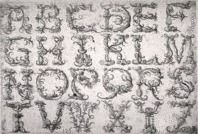
Daniel Hopfer (German , c. 1470-1536), Alphabet of Roman Capital Roman letters with metaphorical ornaments, 15th-16th century, etching, 15.6 x 22.6 cm (image) inches,
Fine Arts Museums of San Francisco, CA. See capital
letters.
Quote:
"Ornamental" and "ornate" are used in referring to the third style of classical Roman fresco painting. This style followed those called "incrustation" and "architectonic" styles, and preceded the composite style.
Related link:
Also see aesthetics, bric-a-brac, brummagem, egg-and-dart, embroidery, festoon, finial, flourish, gem, gewgaw, historiated, hooptedoodle, jewelry, niche, openwork, pendant, taste, and tchotchke.
ornate - Elaborately, even excessively ornamental; showy. In typography, highly ornamental characters, usually letters. In the Middle Ages, such letters were used as decorative initial letters on pages of manuscripts and books. Today ornate letters are used as novel, decorrative elements employed very selectively in graphic design. Ornate is sometimes used to mean baroque or complex.
"Ornate" and "ornamental" are used in referring to the third style of classical Roman fresco painting. This style followed those called "incrustation" and "architectonic" styles, and preceded the composite style.
Related link:
Orphism - A style of painting related to Cubism, sometimes called Orphic Cubism, that employed overlapping planes of bright, contrasting colors. It was generally both more abstract and more colorful than other forms of Cubism. The name, chosen by the poet Guillaume Apollinaire (French, 1880-1918) in 1913, harkened back to Orpheus, the singer and poet of Greek mythology. Painter Robert Delaunay (French, 1885-1941) and his wife Sonia Delaunay-Terk (French, 1885-1979) were its chief exponents, beginning in 1912. He preferred the name Simultaneism. Other artists at times associated with this style were Frantisek [Franz or Frank] Kupka (Czech, 1871-1957), Francis Picabia (French, 1879-1953), Fernand Leger (French, 1881-1955), and Marcel Duchamp (French, 1887-1968).
(pr. OHR-fəzm)
Examples:
František Kupka (Czech, 1871-1957), The First Step, 1910-13? (dated on painting 1909), oil on canvas, 53 3/8 x 33 5/8 inches (83.2 x 129.6 cm), Museum of Modern Art, NY.
František Kupka, Amorpha: Fugue in Two Colors, 1912, gouache on paper, 8 3/8 x 9 inches (21.3 x 22.9 cm), Museum of Modern Art, NY.

František Kupka, Hindu Motif, c. 1919-1923, oil
on canvas, 124.5 x 122 cm,
Georges Pompidou Center, Paris. See czech.

František Kupka, Study from Mechanistic Series, 1923-1926,
gouache and pencil
on paper, 28 x 28.2 cm, Tehran Museum
of Contemporary Art, Iran.
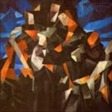
Francis Picabia (French, 1879-1953), The Procession, Seville (La Procession, Seville),
1912, oil on canvas,
48 x 48 inches, private collection. This painting was exhibited
in the influential Armory Show of
1913.
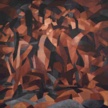
Francis Picabia, The Spring (La Source), June-September 1912, oil on canvas, 8 feet 2 1/4 inches x 8 feet 2 1/8 inches (249.6 x 249.3 cm), Museum of Modern Art, NY.
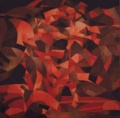
Francis Picabia, Dances at the Spring (Danses à la source), June-September 1912, oil on canvas, 8 feet 3 1/8 inches x 8 feet 2 inches (251.8 x 248.9 cm), Museum of Modern Art, NY.
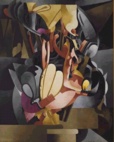
Francis Picabia, I See Again in Memory My Dear Udnie (Je revois en souvenir ma chère Udnie), 1914, perhaps begun 1913, oil on canvas, 8 feet 2 1/2 inches x 6 feet 6 1/4 inches (250.2 x 198.8 cm), Museum of Modern Art, NY.

Francis Picabia, New York, 1913, gouache, watercolor, and pencil on paper, 22 x 29 7/8 inches (55.8 x 75.9 cm), Museum of Modern Art, NY.

Francis Picabia, Comic Wedlock (Mariage comique), c. June-July) 1914, oil on canvas, 6 feet 5 3/8 inches x 6 feet 6 3/4 inches (196.5 x 200 cm), Museum of Modern Art, NY.

Francis Picabia, This Has to Do with Me (C'est de moi qu'il s'agit), c. June-July 1914, oil on canvas, 6 feet 6 5/8 inches x 6 feet 6 3/8 inches (199.8 x 199.2 cm), Museum of Modern Art, NY. Picabia had starting to edge toward Dada.

Robert Delaunay (French, 1885-1941), Study for 'The City', 1909-1910, oil on canvas,
88.3 x 124.5 cm, Tate Gallery, London.
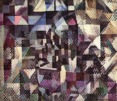
Robert Delaunay, Window on the City, No. 4 (Les Fenêtres
sur la ville), 1910-11, oil
on canvas, 44 3/4 x 51 1/2.
This painting was exhibited in the influential Armory
Show of 1913.

Robert Delaunay, Windows Open Simultaneously (First Part, Third
Motif), 1912, oil
on canvas, 45.7 x 37.5 cm,
Tate Gallery, London.
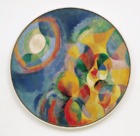
Robert Delaunay, Simultaneous Contrasts: Sun and Moon, 1913
(dated 1912), oil on canvas,
diameter 53 inches (134.5
cm), Museum of Modern Art, NY. See circle.

Robert Delaunay, Joie de vivre (The Joy of Life), 1930
, oil on canvas,
200 x 228 cm, Georges Pompidou Center, Paris.

Robert Delaunay, Rhythm, 1934 , oil
on canvas, 145 x 113 cm, Georges
Pompidou Center, Paris.
Sonia Delaunay (born Sarah Sophie Stern Terk) (French, born Russia, 1885-1979), Prose on the Trans-Siberian Railway and of Little Jehanne of France, 1913, 195.6 x 35.6 cm, Tate Gallery, London.

Sonia Delaunay, Electric Prisms, 1914, oil
on canvas, 250 x 250 cm, Georges
Pompidou Center, Paris.

Sonia Delaunay, Rhythm, 1938, oil
on canvas, 182 x 149 cm, Georges
Pompidou Center, Paris.
American painters Morgan Russell (1886-1953) and Stanton MacDonald-Wright (1890-1973), who exhibited pictures in a similar style in 1913, referred to their style as Synchromism.
Also see isms and -ism.
orpiment - A particular yellow pigment.
Related resource:
orthodox and orthodoxy - Adhering to or agreeing with the accepted, traditional and established doctrine, an acknowledged standard, a traditional form, or an established religion; conventional. Or, holding orthodox opinions or doctrines. The opposite of orthodox is heterodox. Also see academic, p.c., and popular culture.
orthogonal line - A straight line imagined to be behind and perpendicular to the picture plane. The orthagonals in a painting appear to converge on each other as they recede toward one or more vanishing points on the horizon.
Also see linear perspective.
ostentatious - Given to showing off, pretentious, meant to impress others. A person or thing that is ostentatious is boastfully showy. Some of the many interesting synomyms: flashy, flaunting, florid, pompous, turgid, bombastic, swaggering, strutting, peacockish, gaudy, grandiose, grandiloquent, highfalutin, orotund, and orchidaceous (an ostentatious word in itself!).
However appropriate it may be, to criticize a person or thing for being ostentatious is accusatory. Caution!: Most people are averse to ostracism. Unless an odious motive can be identified, one may be wise to employ less accusatory terms in describing a person or thing that is simply odd. Consider alternatives: e.g., strange, weird, peculiar, eccentric, or quirky. It is inappropriate to use even these without making (or at least preparing) a case for their use.
If a bold display is more innocently or playfully celebratory — lacking the element of self-importance — then it might be described as flamboyant. One that is simply odd might be eccentric. Opposites of ostentatious are: modest, reserved, inconspicuous, plain, simple, and minimal.
Also see bad art, buckeye, ersatz, fake, gild the lily, kitsch, low art, baroque, rococo, sublime, and truth.
ostraca or ostraka - Plural form of ostracon or ostrakon.
ostracon or ostrakon - Shards of limestone or broken pottery used for sketching by an Egyptian and Greek artists. The Greek word ostracon literally meant oystershell.
The Greeks wrote names on fragments of broken pottery or tile as ballots when voting to exile someone who represented a danger to the state. An ancient anecdote about such ostraca (the plural form):
Aristides the Just was once handed a potsherd
by an illiterate fellow citizen, who asked him to scratch "Aristides"
on it.
As Aristides started to write, he asked the man, "What's
so bad about Aristides?"
"I'm just tired of hearing him called 'the Just,'"
the fellow replied.
Examples of ostraca (or ostraka) have been found dating to all periods of ancient Egypt:

Egyptian, Thebes, Ostracon
of Senenmut, c. 1473-58 BCE,
Dynasty 18, reign of Hatshepsut, painted limestone,
8 7/8 x 7 1/4 inches (22.5 x 18.1 cm), Metropolitan Museum of
Art, NY.
Egypt, Thebes, Ostracon, The Valley of the Kings, Dynasty 20, c. 1185-1070 BCE, painted limestone, Semitic Museum, Harvard U, lent to Michael C. Carlos Museum, Emory U, Atlanta, GA.

Egypt, Thebes, Ostracon, c. 1295-?1069 BCE,
Dynasties 19-20, New Kingdom, painted limestone,
5 1/2 x 4 3/4 inches (14 x 12.5 cm), Metropolitan Museum of Art,
NY.
ottocento - Italian, literally "eight hundred," it refers to the 1800s — the nineteenth century, and is often used to refer to Italian art of the period. It was the age of nationalism throughout Europe. Italy during the ottocento, after centuries of regional fragmentation and foreign domination, became a united political entity. The political struggle for unification was known as the Risorgimento, meaning to rise up again (evoking similarly powerful alliterative words like renaissance and resurrection). The term was chosen because Italians hoped that their land might overcome internal political divisions and regionalism to regain the prominent place in Western Civilization it had enjoyed during the Roman and Renaissance times, when the Italic peninsula had been a rich and vital center.
| Italian term | Numerically | English term |
|---|---|---|
| duecento | 1200s | thirteenth century |
| trecento | 1300s | fourteenth century |
| quattrocento | 1400s | fifteenth century |
| cinquecento | 1500s | sixteenth century |
| seicento | 1600s | seventeenth century |
| settecento | 1700s | eighteenth century |
| ottocento | 1800s | nineteenth century |
| novecento | 1900s | twentieth century |
| diecicento | 2000s | twenty-first century |
Also see Segantini stitch.
ounce - A unit of dry as well as liquid weight measurement (in the US). To convert ounces (US dry) into grams, multiply by 28.3495; into pound, divide by 16. To convert ounces (US fluid) into cubic inches, multiply by 1.80469; into liters, x 0.02957; into pint, x 0.0625; into tablespoons, x 2. Abbreviated oz.
outline drawing - A diagram or silhouette, made with one line defining the perimeter of a form, flat and two-dimensional.
Example:
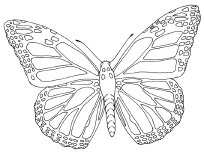
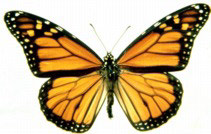
An outline drawing of a monarch butterfly,
and
a photograph
of one.
Also see contour drawing.
outsider art or Outsider art and outsiders or Outsiders - Strictly interpreted, outsider art refers to works by those outside of mainstream society. In the United States, outsider art broadly includes folk and ethnic art as well as by prisoners, the mentally ill, children, and others neither trained in art nor making their works to sell them. In Europe, outsider art is more narrowly interpreted as art by the mentally disturbed. The term naive art was once applied to this work, but is no longer considered current. Because fewer and fewer people are sufficiently isolated to be truly outsiders, most are either mentally ill or working far from urban art scenes.
Also see art brut, artworld, folk art, and obsession.
oval - An egg-like two-dimensional shape that looks like a circle that has been stretched to make it longer. The two ends of an oval may or may not be the same size and shape. Oval can be either a noun or an adjective. A three-dimensional form with oval shape is an ovoid.
(pr. OH-vəl)
Examples:

Dexamenos (Greek, Chios), Intaglio of a Flying Heron, 5th century
BCE,
chalcedony, gold,
1.7 x 2.2 cm, State Hermitage Museum, St. Petersburg, Russia.
See Greek art.

François Boucher (French, 1703-1770),
Shepherd and Shepherdess Reposing (The School
of Love), 1761, oil
on canvas, relined, 76.6 x
63.6 cm, Wallace Collection, London. See Rococo.
Mathew Brady (American, 1823-1896) Studio, Robert E. Lee (1807-1870), 1865, albumen silver print, 8 3/16 x 6 inches (20.8 x 15.3 cm), National Portrait Gallery, Smithsonian Institution, Washington, DC. This photograph was cropped to an oval shape.

Dame Barbara Hepworth (English, 1903-1975),
Oval Sculpture (No. 2), 1943, cast
1958, plaster,
29.3 x 40.0 x 25.5 cm, Tate Gallery, London. Because oval refers
to a two-dimensional shape, this three-dimensional form would
better be described as ovoid or ovate — shaped like an egg.
See sculpture.
Also see curve, edge, ellipse, grisaille, and oblong.
ovate - See ovoid.
overglaze - A decoration applied to a ceramic piece after glazing.
overlap - When one thing lies over, partly covering something else. Depicting this is one of the most important means of conveying an illusion of depth. (Other means include varying sizes and placement on a receding plane, along with linear and aerial perspective.) [Is the opposite of overlap underlap?]
Quote:
Also see aerial perspective, align, butt, feather, fold, imbrication, kern and kerning, linear perspective, moiré, tile, and tiling.
overlay - Something — perhaps a layer of paint or some other material, such as wood veneer or gold leaf — that is laid over or covers another surface. It may also be a transparent sheet like an acetate or cel containing images in some areas areas, which is placed atop another image to be incorporated into it.
Examples:
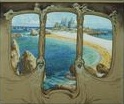
František [aka Franz or Frank] Kupka (Czech, 1871-1957), View from a Carriage Window, c. 1901, gouache and watercolor on paper with cardboard overlay, with cut out overlay: 19 7/8 x 23 5/8 inches (50.6 x 60 cm), Museum of Modern Art, NY. See Art Nouveau, Symbolism, and Orphism.
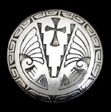
Tom Bahe (Navajo-American, contemporary),
Pendant &
Pin Combination, c. 2001, sterling silver
overlay, diameter, 2 1/2
inches. This piece of jewelry is constructed of two sheets of
silver soldered together,
the top one having a pierced design laminated
to the lower one which is solid.

A digitally produced overlay of a partially transparent photo of one
golpher onto the photo of another. This overlay was made
in order to compare the
swings of the two golfers. In Adobe Photoshop,
"overlay" is a tool or action between "multiply"
and "screen." It either multiplies or screens, depending
on the value of the pixel
underneath. Overall the effect is that the bottom pixel is not
replaced by the upper pixel, but is mixed with it, weighted by
the value of the original color.
Also see animation, bleeding through, and overlap.
overpainting - A finishing layer of paint applied over another layer of paint, or underlayer, once it has dried.
Also see fat over lean, glaze, pentimento, scumble, and dragging.
ovoid -  A three-dimensional form shaped like an egg — oval from some points of view, and circular from others. The adjectival form can be either ovoid or ovate, although ovate can refer to something either two- or three-dimensional.
A three-dimensional form shaped like an egg — oval from some points of view, and circular from others. The adjectival form can be either ovoid or ovate, although ovate can refer to something either two- or three-dimensional.
(pr. OH-voyd)
Example:


Matti Suuronen (Finnish architect, 1933-), Futuro, 1968, a "futuristic" house resembling a
 flying saucer, it has a fiberglass exterior, height 4 m, diameter 8 m, volume 140 cubic m, weight without furnishings, 2,500 kg, manufactured in several locations around the world. It appears ovoid in every elevation view, although it is circular in plan. The shape is repeated in the design's twelve oval windows.
flying saucer, it has a fiberglass exterior, height 4 m, diameter 8 m, volume 140 cubic m, weight without furnishings, 2,500 kg, manufactured in several locations around the world. It appears ovoid in every elevation view, although it is circular in plan. The shape is repeated in the design's twelve oval windows. A model of the Futuro. Visit Futuro-House.net and model.
Also see biomorphic, edge, ellipse, curve, oblong, sphere, and volume.
ox gall, oxgall or ox-gall - A waterless,
oil- and water-soluble,
 translucent,
nearly transparent brown liquid,
ox gall is the bile taken from the gall bladder of a cow. It is
used with watercolors,
in engraving,
in marbling, and in lithography as a wetting
agent — reducing what's called the "surface tension"
of liquids, improving water's ability to penetrate and be absorbed. It is also used in the
marbling of paper to more smoothly disperse oil
color on the size.
Ox gall has a long history of use, but often replacing them today
are modern synthetic wetting
agents available from art supply dealers (photographic and general
chemical supply dealers too) in bottle, dropper-bottle, and aerosol
forms. Ox gall and other wetting agents are also employed to eliminate
pin-holes in gesso surfaces,
by mixing it into the gesso before the gesso is applied. Also
see absorption, binder,
marbling, and medium.
translucent,
nearly transparent brown liquid,
ox gall is the bile taken from the gall bladder of a cow. It is
used with watercolors,
in engraving,
in marbling, and in lithography as a wetting
agent — reducing what's called the "surface tension"
of liquids, improving water's ability to penetrate and be absorbed. It is also used in the
marbling of paper to more smoothly disperse oil
color on the size.
Ox gall has a long history of use, but often replacing them today
are modern synthetic wetting
agents available from art supply dealers (photographic and general
chemical supply dealers too) in bottle, dropper-bottle, and aerosol
forms. Ox gall and other wetting agents are also employed to eliminate
pin-holes in gesso surfaces,
by mixing it into the gesso before the gesso is applied. Also
see absorption, binder,
marbling, and medium.
oxidation firing - A glazing technique in which additional oxygen is introduced into a kiln while firing.
oxide - Any element combined with oxygen. Common rust is iron oxide, one of the most widely used colorants — making red bricks red for example. Silver's oxide is more often referred to as tarnish. Bronze's is more often referred to as a patina. Pure gold cannot oxidize. There are several ways to remove oxides from metals, and one is by pickling.
Also see antimony and pigment.
oxygen - A colorless, odorless, tasteless, non-explosive gas, it is the most abundant element on earth, constituting about half of the surface material. It makes up about 9/10 of water, two-thirds of the human body, and 1/5 (by volume) of air. Normal atmospheric oxygen is O2. Oxygen forms compounds with almost all of the elements except the inert gases. The common reaction in which it unites with another substance is called oxidation. The burning of substances in air is rapid oxidation, or combustion, oxygen being required for nearly all combustion. Among its chief uses by artists is supporting the combustion of the oxyacetylene torch in welding. Tank sizes available: 20, 40, 80, 122, and 244 cubic feet. Atomic symbol O, atomic number 8.
Also see acetylene, argon, carbon dioxide, helium, hydrogen, nitrogen, oxidation firing, and oxide.
oz. - Abbreviation for ounce.
Also see measure.
https://inform.quest/_art